Comprehensive Report: UK Business Operations, Structures, and Analysis
VerifiedAdded on 2022/12/23
|13
|3323
|420
Report
AI Summary
This report provides a comprehensive overview of business operations, focusing on the UK context. It begins by outlining different types of organizations in the public and private sectors, followed by an exploration of various business structures prevalent in the UK, including sole proprietorships, partnerships, and limited companies, along with reasons for variations in these structures. The report then emphasizes the importance of accounting for business success, detailing key HR functions such as recruitment and compensation, and summarizing employment legislation. A profit and loss account is presented with interpretation of information, followed by an analysis of team roles and stages of team development. Furthermore, the report assesses motivation theories, including McClelland's theory of needs and Vroom's expectancy theory, and concludes with a discussion of different leadership styles and a PESTLE analysis of Mark and Spencer.
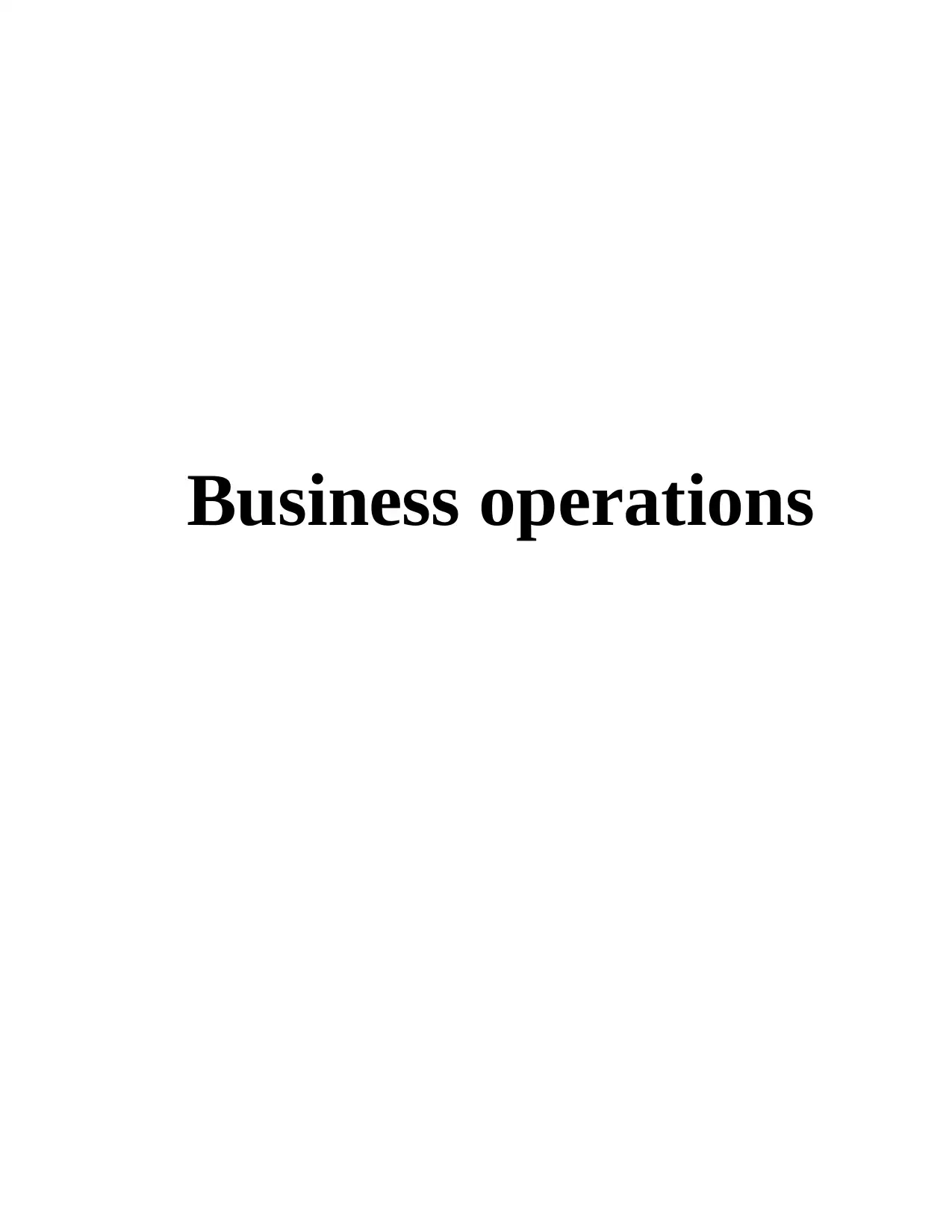
Business operations
Paraphrase This Document
Need a fresh take? Get an instant paraphrase of this document with our AI Paraphraser
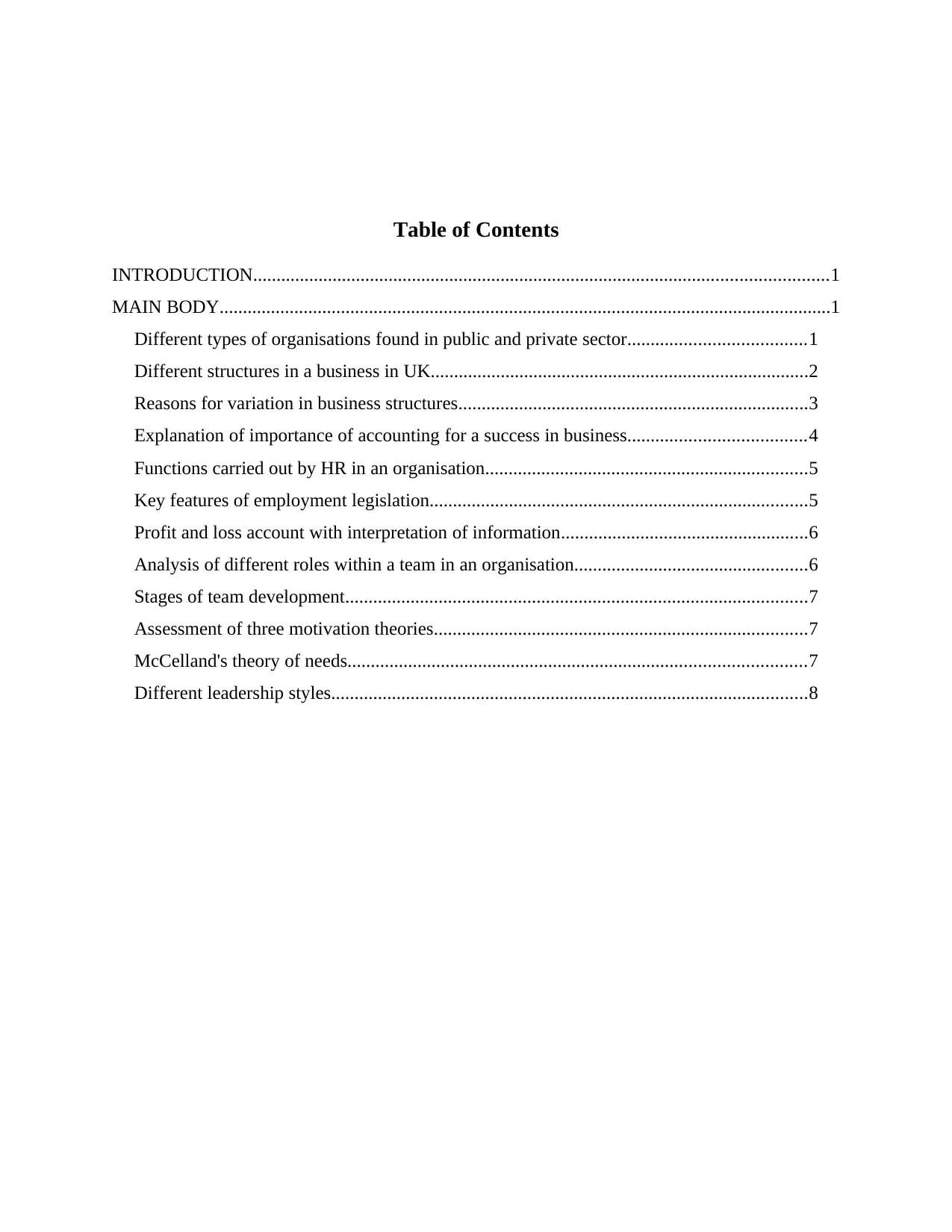
Table of Contents
INTRODUCTION...........................................................................................................................1
MAIN BODY...................................................................................................................................1
Different types of organisations found in public and private sector......................................1
Different structures in a business in UK.................................................................................2
Reasons for variation in business structures...........................................................................3
Explanation of importance of accounting for a success in business......................................4
Functions carried out by HR in an organisation.....................................................................5
Key features of employment legislation.................................................................................5
Profit and loss account with interpretation of information.....................................................6
Analysis of different roles within a team in an organisation..................................................6
Stages of team development...................................................................................................7
Assessment of three motivation theories................................................................................7
McCelland's theory of needs..................................................................................................7
Different leadership styles......................................................................................................8
INTRODUCTION...........................................................................................................................1
MAIN BODY...................................................................................................................................1
Different types of organisations found in public and private sector......................................1
Different structures in a business in UK.................................................................................2
Reasons for variation in business structures...........................................................................3
Explanation of importance of accounting for a success in business......................................4
Functions carried out by HR in an organisation.....................................................................5
Key features of employment legislation.................................................................................5
Profit and loss account with interpretation of information.....................................................6
Analysis of different roles within a team in an organisation..................................................6
Stages of team development...................................................................................................7
Assessment of three motivation theories................................................................................7
McCelland's theory of needs..................................................................................................7
Different leadership styles......................................................................................................8
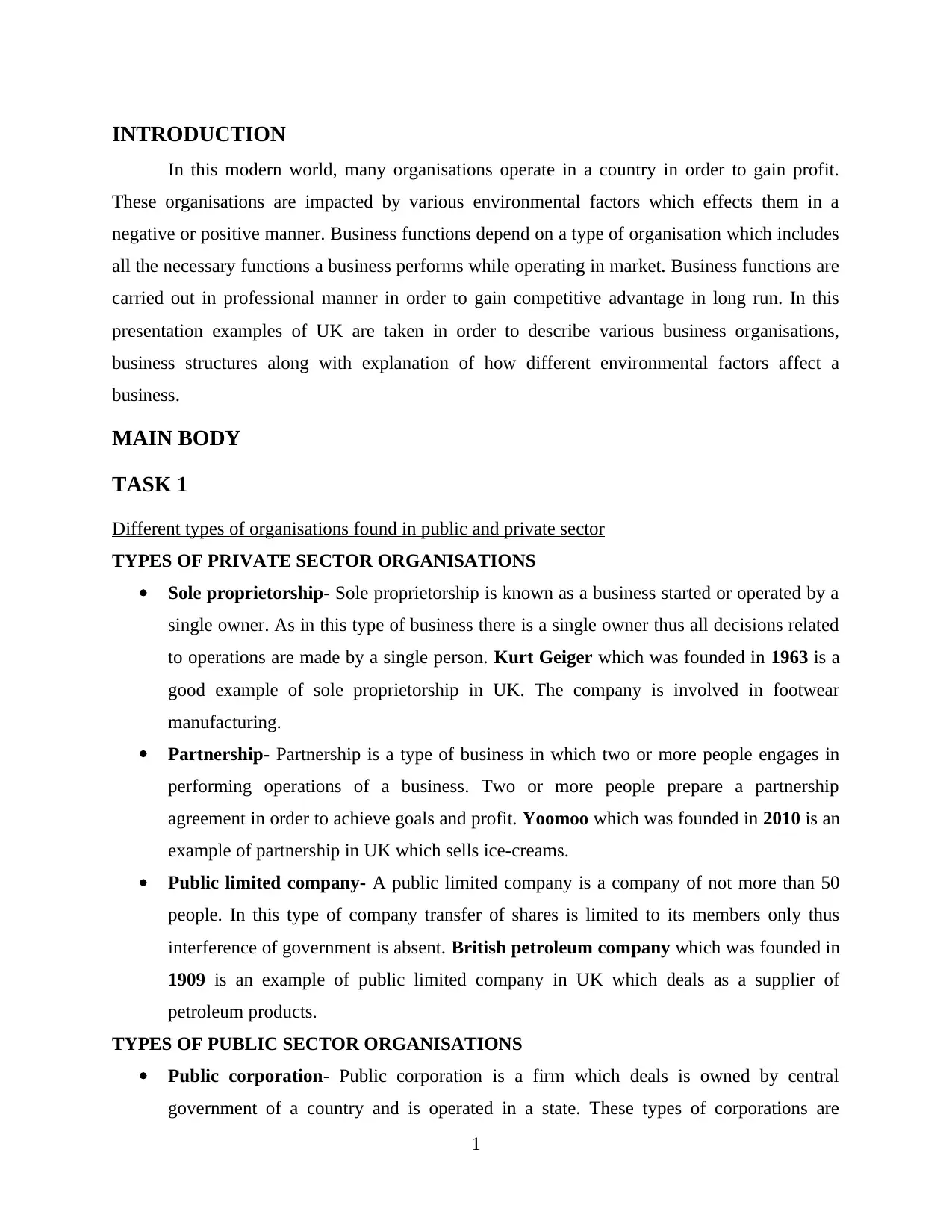
INTRODUCTION
In this modern world, many organisations operate in a country in order to gain profit.
These organisations are impacted by various environmental factors which effects them in a
negative or positive manner. Business functions depend on a type of organisation which includes
all the necessary functions a business performs while operating in market. Business functions are
carried out in professional manner in order to gain competitive advantage in long run. In this
presentation examples of UK are taken in order to describe various business organisations,
business structures along with explanation of how different environmental factors affect a
business.
MAIN BODY
TASK 1
Different types of organisations found in public and private sector
TYPES OF PRIVATE SECTOR ORGANISATIONS
Sole proprietorship- Sole proprietorship is known as a business started or operated by a
single owner. As in this type of business there is a single owner thus all decisions related
to operations are made by a single person. Kurt Geiger which was founded in 1963 is a
good example of sole proprietorship in UK. The company is involved in footwear
manufacturing.
Partnership- Partnership is a type of business in which two or more people engages in
performing operations of a business. Two or more people prepare a partnership
agreement in order to achieve goals and profit. Yoomoo which was founded in 2010 is an
example of partnership in UK which sells ice-creams.
Public limited company- A public limited company is a company of not more than 50
people. In this type of company transfer of shares is limited to its members only thus
interference of government is absent. British petroleum company which was founded in
1909 is an example of public limited company in UK which deals as a supplier of
petroleum products.
TYPES OF PUBLIC SECTOR ORGANISATIONS
Public corporation- Public corporation is a firm which deals is owned by central
government of a country and is operated in a state. These types of corporations are
1
In this modern world, many organisations operate in a country in order to gain profit.
These organisations are impacted by various environmental factors which effects them in a
negative or positive manner. Business functions depend on a type of organisation which includes
all the necessary functions a business performs while operating in market. Business functions are
carried out in professional manner in order to gain competitive advantage in long run. In this
presentation examples of UK are taken in order to describe various business organisations,
business structures along with explanation of how different environmental factors affect a
business.
MAIN BODY
TASK 1
Different types of organisations found in public and private sector
TYPES OF PRIVATE SECTOR ORGANISATIONS
Sole proprietorship- Sole proprietorship is known as a business started or operated by a
single owner. As in this type of business there is a single owner thus all decisions related
to operations are made by a single person. Kurt Geiger which was founded in 1963 is a
good example of sole proprietorship in UK. The company is involved in footwear
manufacturing.
Partnership- Partnership is a type of business in which two or more people engages in
performing operations of a business. Two or more people prepare a partnership
agreement in order to achieve goals and profit. Yoomoo which was founded in 2010 is an
example of partnership in UK which sells ice-creams.
Public limited company- A public limited company is a company of not more than 50
people. In this type of company transfer of shares is limited to its members only thus
interference of government is absent. British petroleum company which was founded in
1909 is an example of public limited company in UK which deals as a supplier of
petroleum products.
TYPES OF PUBLIC SECTOR ORGANISATIONS
Public corporation- Public corporation is a firm which deals is owned by central
government of a country and is operated in a state. These types of corporations are
1
⊘ This is a preview!⊘
Do you want full access?
Subscribe today to unlock all pages.

Trusted by 1+ million students worldwide
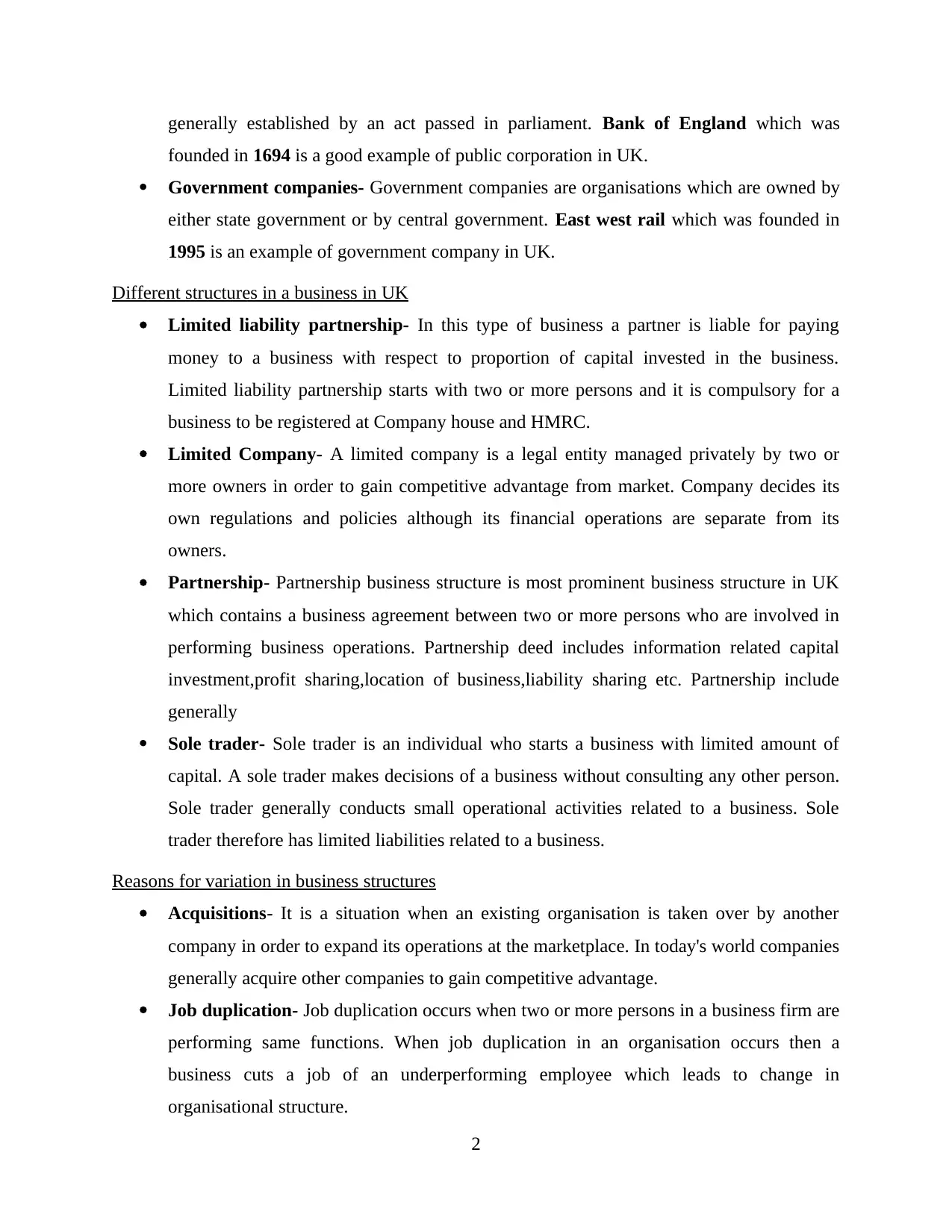
generally established by an act passed in parliament. Bank of England which was
founded in 1694 is a good example of public corporation in UK.
Government companies- Government companies are organisations which are owned by
either state government or by central government. East west rail which was founded in
1995 is an example of government company in UK.
Different structures in a business in UK
Limited liability partnership- In this type of business a partner is liable for paying
money to a business with respect to proportion of capital invested in the business.
Limited liability partnership starts with two or more persons and it is compulsory for a
business to be registered at Company house and HMRC.
Limited Company- A limited company is a legal entity managed privately by two or
more owners in order to gain competitive advantage from market. Company decides its
own regulations and policies although its financial operations are separate from its
owners.
Partnership- Partnership business structure is most prominent business structure in UK
which contains a business agreement between two or more persons who are involved in
performing business operations. Partnership deed includes information related capital
investment,profit sharing,location of business,liability sharing etc. Partnership include
generally
Sole trader- Sole trader is an individual who starts a business with limited amount of
capital. A sole trader makes decisions of a business without consulting any other person.
Sole trader generally conducts small operational activities related to a business. Sole
trader therefore has limited liabilities related to a business.
Reasons for variation in business structures
Acquisitions- It is a situation when an existing organisation is taken over by another
company in order to expand its operations at the marketplace. In today's world companies
generally acquire other companies to gain competitive advantage.
Job duplication- Job duplication occurs when two or more persons in a business firm are
performing same functions. When job duplication in an organisation occurs then a
business cuts a job of an underperforming employee which leads to change in
organisational structure.
2
founded in 1694 is a good example of public corporation in UK.
Government companies- Government companies are organisations which are owned by
either state government or by central government. East west rail which was founded in
1995 is an example of government company in UK.
Different structures in a business in UK
Limited liability partnership- In this type of business a partner is liable for paying
money to a business with respect to proportion of capital invested in the business.
Limited liability partnership starts with two or more persons and it is compulsory for a
business to be registered at Company house and HMRC.
Limited Company- A limited company is a legal entity managed privately by two or
more owners in order to gain competitive advantage from market. Company decides its
own regulations and policies although its financial operations are separate from its
owners.
Partnership- Partnership business structure is most prominent business structure in UK
which contains a business agreement between two or more persons who are involved in
performing business operations. Partnership deed includes information related capital
investment,profit sharing,location of business,liability sharing etc. Partnership include
generally
Sole trader- Sole trader is an individual who starts a business with limited amount of
capital. A sole trader makes decisions of a business without consulting any other person.
Sole trader generally conducts small operational activities related to a business. Sole
trader therefore has limited liabilities related to a business.
Reasons for variation in business structures
Acquisitions- It is a situation when an existing organisation is taken over by another
company in order to expand its operations at the marketplace. In today's world companies
generally acquire other companies to gain competitive advantage.
Job duplication- Job duplication occurs when two or more persons in a business firm are
performing same functions. When job duplication in an organisation occurs then a
business cuts a job of an underperforming employee which leads to change in
organisational structure.
2
Paraphrase This Document
Need a fresh take? Get an instant paraphrase of this document with our AI Paraphraser
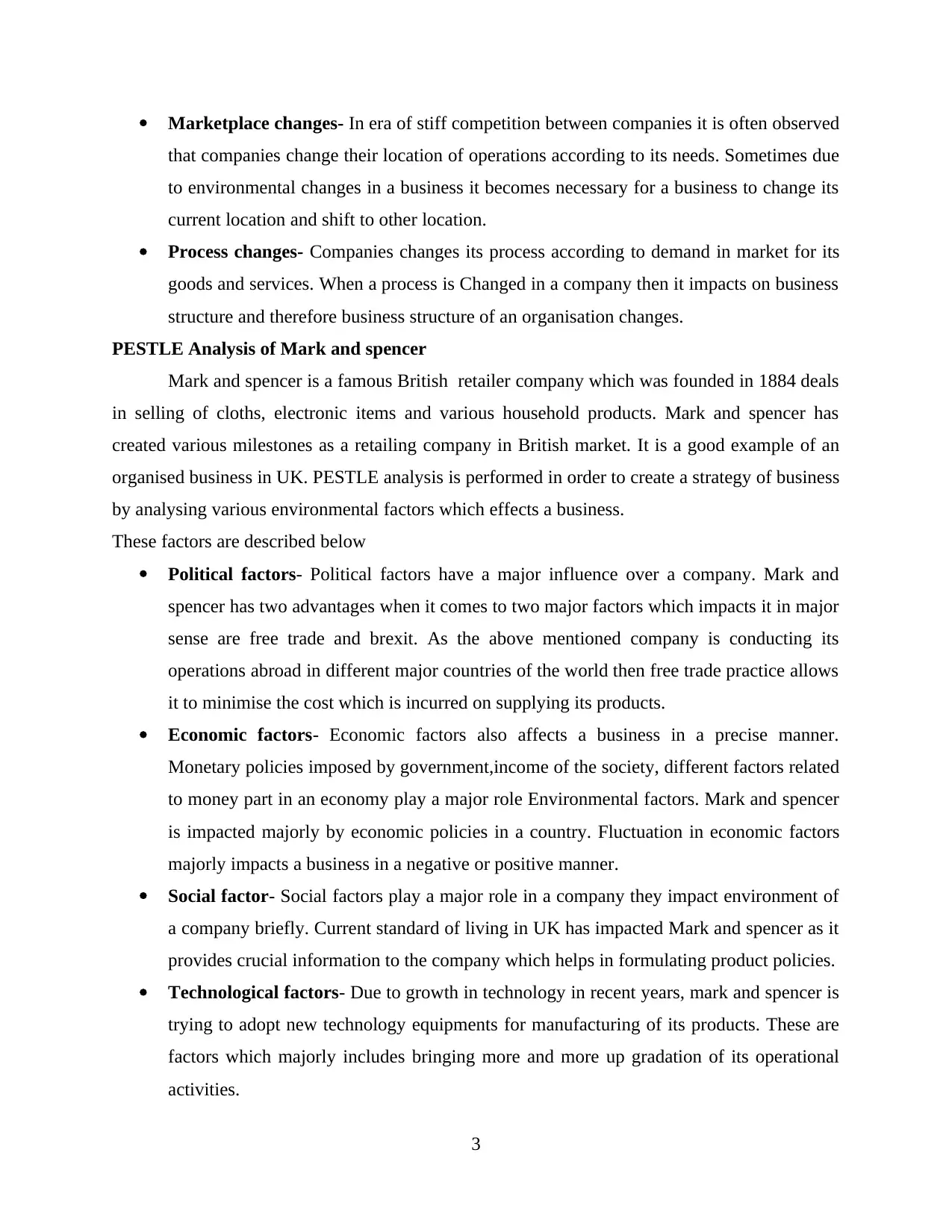
Marketplace changes- In era of stiff competition between companies it is often observed
that companies change their location of operations according to its needs. Sometimes due
to environmental changes in a business it becomes necessary for a business to change its
current location and shift to other location.
Process changes- Companies changes its process according to demand in market for its
goods and services. When a process is Changed in a company then it impacts on business
structure and therefore business structure of an organisation changes.
PESTLE Analysis of Mark and spencer
Mark and spencer is a famous British retailer company which was founded in 1884 deals
in selling of cloths, electronic items and various household products. Mark and spencer has
created various milestones as a retailing company in British market. It is a good example of an
organised business in UK. PESTLE analysis is performed in order to create a strategy of business
by analysing various environmental factors which effects a business.
These factors are described below
Political factors- Political factors have a major influence over a company. Mark and
spencer has two advantages when it comes to two major factors which impacts it in major
sense are free trade and brexit. As the above mentioned company is conducting its
operations abroad in different major countries of the world then free trade practice allows
it to minimise the cost which is incurred on supplying its products.
Economic factors- Economic factors also affects a business in a precise manner.
Monetary policies imposed by government,income of the society, different factors related
to money part in an economy play a major role Environmental factors. Mark and spencer
is impacted majorly by economic policies in a country. Fluctuation in economic factors
majorly impacts a business in a negative or positive manner.
Social factor- Social factors play a major role in a company they impact environment of
a company briefly. Current standard of living in UK has impacted Mark and spencer as it
provides crucial information to the company which helps in formulating product policies.
Technological factors- Due to growth in technology in recent years, mark and spencer is
trying to adopt new technology equipments for manufacturing of its products. These are
factors which majorly includes bringing more and more up gradation of its operational
activities.
3
that companies change their location of operations according to its needs. Sometimes due
to environmental changes in a business it becomes necessary for a business to change its
current location and shift to other location.
Process changes- Companies changes its process according to demand in market for its
goods and services. When a process is Changed in a company then it impacts on business
structure and therefore business structure of an organisation changes.
PESTLE Analysis of Mark and spencer
Mark and spencer is a famous British retailer company which was founded in 1884 deals
in selling of cloths, electronic items and various household products. Mark and spencer has
created various milestones as a retailing company in British market. It is a good example of an
organised business in UK. PESTLE analysis is performed in order to create a strategy of business
by analysing various environmental factors which effects a business.
These factors are described below
Political factors- Political factors have a major influence over a company. Mark and
spencer has two advantages when it comes to two major factors which impacts it in major
sense are free trade and brexit. As the above mentioned company is conducting its
operations abroad in different major countries of the world then free trade practice allows
it to minimise the cost which is incurred on supplying its products.
Economic factors- Economic factors also affects a business in a precise manner.
Monetary policies imposed by government,income of the society, different factors related
to money part in an economy play a major role Environmental factors. Mark and spencer
is impacted majorly by economic policies in a country. Fluctuation in economic factors
majorly impacts a business in a negative or positive manner.
Social factor- Social factors play a major role in a company they impact environment of
a company briefly. Current standard of living in UK has impacted Mark and spencer as it
provides crucial information to the company which helps in formulating product policies.
Technological factors- Due to growth in technology in recent years, mark and spencer is
trying to adopt new technology equipments for manufacturing of its products. These are
factors which majorly includes bringing more and more up gradation of its operational
activities.
3
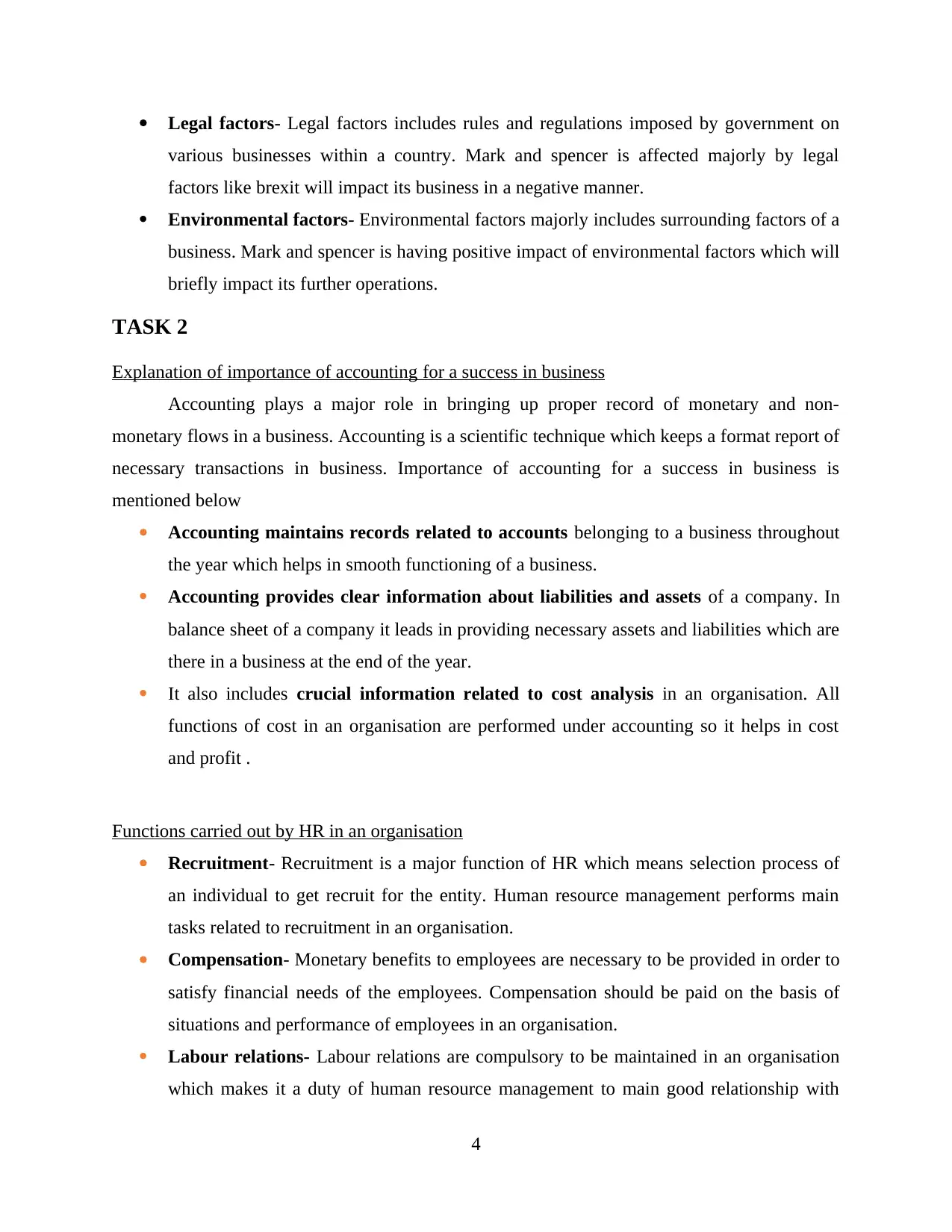
Legal factors- Legal factors includes rules and regulations imposed by government on
various businesses within a country. Mark and spencer is affected majorly by legal
factors like brexit will impact its business in a negative manner.
Environmental factors- Environmental factors majorly includes surrounding factors of a
business. Mark and spencer is having positive impact of environmental factors which will
briefly impact its further operations.
TASK 2
Explanation of importance of accounting for a success in business
Accounting plays a major role in bringing up proper record of monetary and non-
monetary flows in a business. Accounting is a scientific technique which keeps a format report of
necessary transactions in business. Importance of accounting for a success in business is
mentioned below
Accounting maintains records related to accounts belonging to a business throughout
the year which helps in smooth functioning of a business.
Accounting provides clear information about liabilities and assets of a company. In
balance sheet of a company it leads in providing necessary assets and liabilities which are
there in a business at the end of the year.
It also includes crucial information related to cost analysis in an organisation. All
functions of cost in an organisation are performed under accounting so it helps in cost
and profit .
Functions carried out by HR in an organisation
Recruitment- Recruitment is a major function of HR which means selection process of
an individual to get recruit for the entity. Human resource management performs main
tasks related to recruitment in an organisation.
Compensation- Monetary benefits to employees are necessary to be provided in order to
satisfy financial needs of the employees. Compensation should be paid on the basis of
situations and performance of employees in an organisation.
Labour relations- Labour relations are compulsory to be maintained in an organisation
which makes it a duty of human resource management to main good relationship with
4
various businesses within a country. Mark and spencer is affected majorly by legal
factors like brexit will impact its business in a negative manner.
Environmental factors- Environmental factors majorly includes surrounding factors of a
business. Mark and spencer is having positive impact of environmental factors which will
briefly impact its further operations.
TASK 2
Explanation of importance of accounting for a success in business
Accounting plays a major role in bringing up proper record of monetary and non-
monetary flows in a business. Accounting is a scientific technique which keeps a format report of
necessary transactions in business. Importance of accounting for a success in business is
mentioned below
Accounting maintains records related to accounts belonging to a business throughout
the year which helps in smooth functioning of a business.
Accounting provides clear information about liabilities and assets of a company. In
balance sheet of a company it leads in providing necessary assets and liabilities which are
there in a business at the end of the year.
It also includes crucial information related to cost analysis in an organisation. All
functions of cost in an organisation are performed under accounting so it helps in cost
and profit .
Functions carried out by HR in an organisation
Recruitment- Recruitment is a major function of HR which means selection process of
an individual to get recruit for the entity. Human resource management performs main
tasks related to recruitment in an organisation.
Compensation- Monetary benefits to employees are necessary to be provided in order to
satisfy financial needs of the employees. Compensation should be paid on the basis of
situations and performance of employees in an organisation.
Labour relations- Labour relations are compulsory to be maintained in an organisation
which makes it a duty of human resource management to main good relationship with
4
⊘ This is a preview!⊘
Do you want full access?
Subscribe today to unlock all pages.

Trusted by 1+ million students worldwide
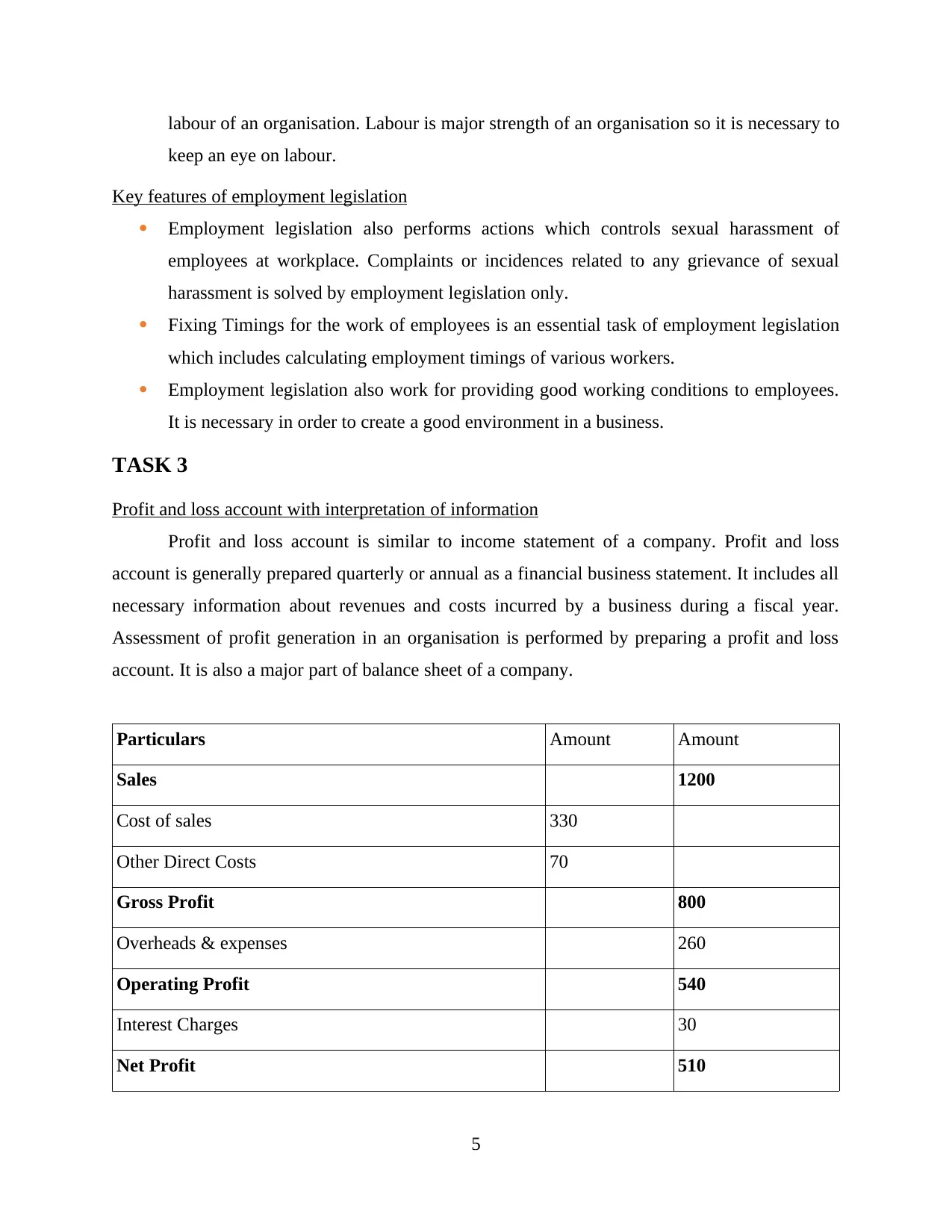
labour of an organisation. Labour is major strength of an organisation so it is necessary to
keep an eye on labour.
Key features of employment legislation
Employment legislation also performs actions which controls sexual harassment of
employees at workplace. Complaints or incidences related to any grievance of sexual
harassment is solved by employment legislation only.
Fixing Timings for the work of employees is an essential task of employment legislation
which includes calculating employment timings of various workers.
Employment legislation also work for providing good working conditions to employees.
It is necessary in order to create a good environment in a business.
TASK 3
Profit and loss account with interpretation of information
Profit and loss account is similar to income statement of a company. Profit and loss
account is generally prepared quarterly or annual as a financial business statement. It includes all
necessary information about revenues and costs incurred by a business during a fiscal year.
Assessment of profit generation in an organisation is performed by preparing a profit and loss
account. It is also a major part of balance sheet of a company.
Particulars Amount Amount
Sales 1200
Cost of sales 330
Other Direct Costs 70
Gross Profit 800
Overheads & expenses 260
Operating Profit 540
Interest Charges 30
Net Profit 510
5
keep an eye on labour.
Key features of employment legislation
Employment legislation also performs actions which controls sexual harassment of
employees at workplace. Complaints or incidences related to any grievance of sexual
harassment is solved by employment legislation only.
Fixing Timings for the work of employees is an essential task of employment legislation
which includes calculating employment timings of various workers.
Employment legislation also work for providing good working conditions to employees.
It is necessary in order to create a good environment in a business.
TASK 3
Profit and loss account with interpretation of information
Profit and loss account is similar to income statement of a company. Profit and loss
account is generally prepared quarterly or annual as a financial business statement. It includes all
necessary information about revenues and costs incurred by a business during a fiscal year.
Assessment of profit generation in an organisation is performed by preparing a profit and loss
account. It is also a major part of balance sheet of a company.
Particulars Amount Amount
Sales 1200
Cost of sales 330
Other Direct Costs 70
Gross Profit 800
Overheads & expenses 260
Operating Profit 540
Interest Charges 30
Net Profit 510
5
Paraphrase This Document
Need a fresh take? Get an instant paraphrase of this document with our AI Paraphraser
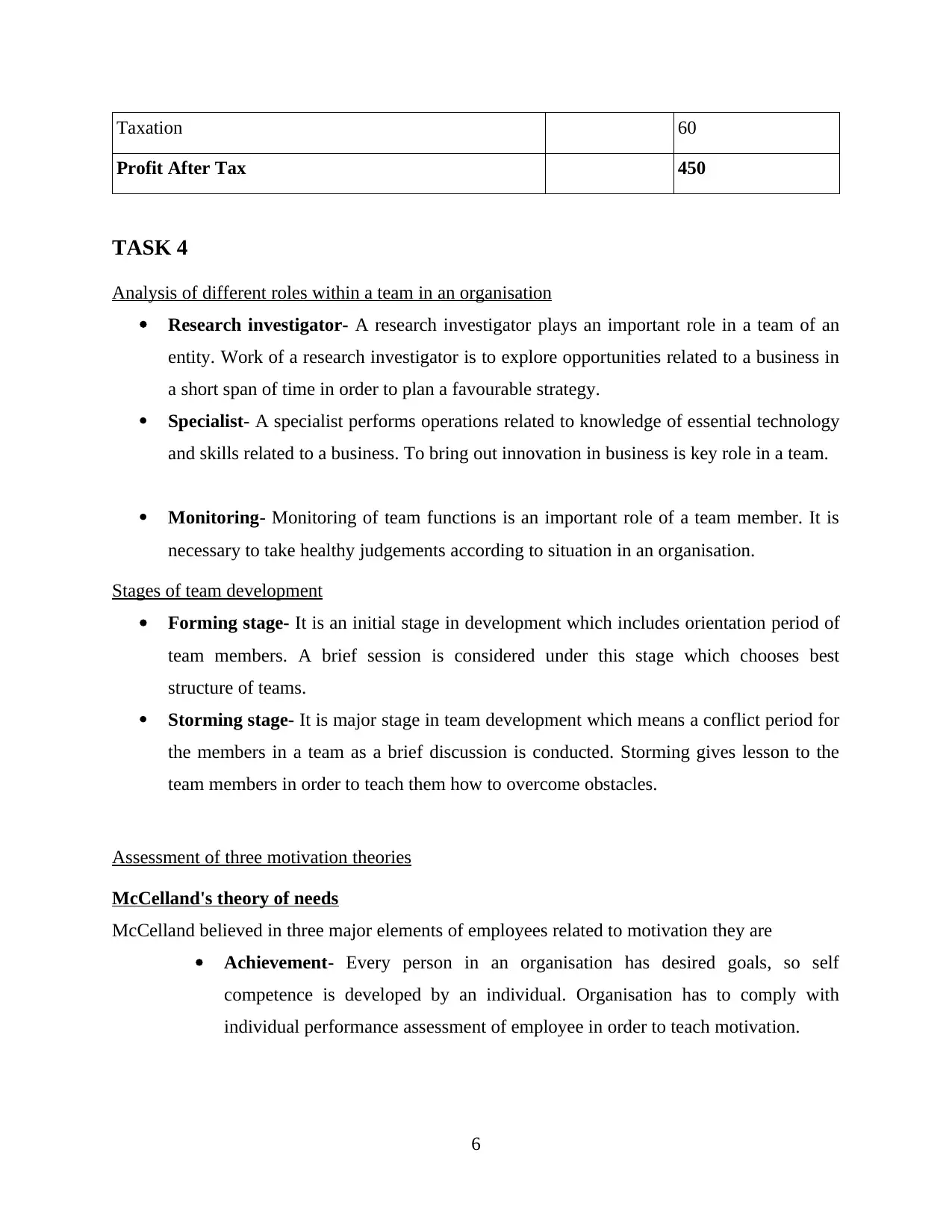
Taxation 60
Profit After Tax 450
TASK 4
Analysis of different roles within a team in an organisation
Research investigator- A research investigator plays an important role in a team of an
entity. Work of a research investigator is to explore opportunities related to a business in
a short span of time in order to plan a favourable strategy.
Specialist- A specialist performs operations related to knowledge of essential technology
and skills related to a business. To bring out innovation in business is key role in a team.
Monitoring- Monitoring of team functions is an important role of a team member. It is
necessary to take healthy judgements according to situation in an organisation.
Stages of team development
Forming stage- It is an initial stage in development which includes orientation period of
team members. A brief session is considered under this stage which chooses best
structure of teams.
Storming stage- It is major stage in team development which means a conflict period for
the members in a team as a brief discussion is conducted. Storming gives lesson to the
team members in order to teach them how to overcome obstacles.
Assessment of three motivation theories
McCelland's theory of needs
McCelland believed in three major elements of employees related to motivation they are
Achievement- Every person in an organisation has desired goals, so self
competence is developed by an individual. Organisation has to comply with
individual performance assessment of employee in order to teach motivation.
6
Profit After Tax 450
TASK 4
Analysis of different roles within a team in an organisation
Research investigator- A research investigator plays an important role in a team of an
entity. Work of a research investigator is to explore opportunities related to a business in
a short span of time in order to plan a favourable strategy.
Specialist- A specialist performs operations related to knowledge of essential technology
and skills related to a business. To bring out innovation in business is key role in a team.
Monitoring- Monitoring of team functions is an important role of a team member. It is
necessary to take healthy judgements according to situation in an organisation.
Stages of team development
Forming stage- It is an initial stage in development which includes orientation period of
team members. A brief session is considered under this stage which chooses best
structure of teams.
Storming stage- It is major stage in team development which means a conflict period for
the members in a team as a brief discussion is conducted. Storming gives lesson to the
team members in order to teach them how to overcome obstacles.
Assessment of three motivation theories
McCelland's theory of needs
McCelland believed in three major elements of employees related to motivation they are
Achievement- Every person in an organisation has desired goals, so self
competence is developed by an individual. Organisation has to comply with
individual performance assessment of employee in order to teach motivation.
6
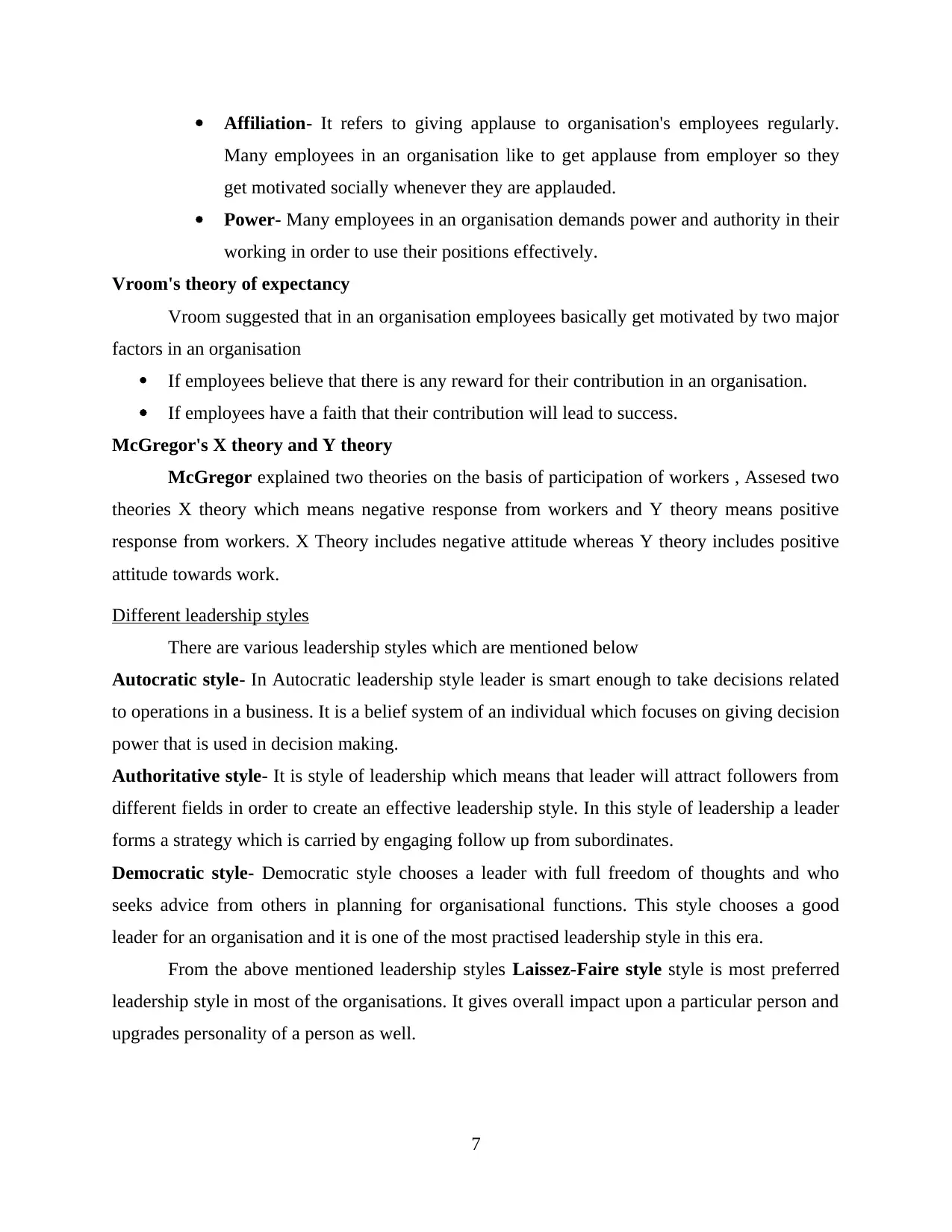
Affiliation- It refers to giving applause to organisation's employees regularly.
Many employees in an organisation like to get applause from employer so they
get motivated socially whenever they are applauded.
Power- Many employees in an organisation demands power and authority in their
working in order to use their positions effectively.
Vroom's theory of expectancy
Vroom suggested that in an organisation employees basically get motivated by two major
factors in an organisation
If employees believe that there is any reward for their contribution in an organisation.
If employees have a faith that their contribution will lead to success.
McGregor's X theory and Y theory
McGregor explained two theories on the basis of participation of workers , Assesed two
theories X theory which means negative response from workers and Y theory means positive
response from workers. X Theory includes negative attitude whereas Y theory includes positive
attitude towards work.
Different leadership styles
There are various leadership styles which are mentioned below
Autocratic style- In Autocratic leadership style leader is smart enough to take decisions related
to operations in a business. It is a belief system of an individual which focuses on giving decision
power that is used in decision making.
Authoritative style- It is style of leadership which means that leader will attract followers from
different fields in order to create an effective leadership style. In this style of leadership a leader
forms a strategy which is carried by engaging follow up from subordinates.
Democratic style- Democratic style chooses a leader with full freedom of thoughts and who
seeks advice from others in planning for organisational functions. This style chooses a good
leader for an organisation and it is one of the most practised leadership style in this era.
From the above mentioned leadership styles Laissez-Faire style style is most preferred
leadership style in most of the organisations. It gives overall impact upon a particular person and
upgrades personality of a person as well.
7
Many employees in an organisation like to get applause from employer so they
get motivated socially whenever they are applauded.
Power- Many employees in an organisation demands power and authority in their
working in order to use their positions effectively.
Vroom's theory of expectancy
Vroom suggested that in an organisation employees basically get motivated by two major
factors in an organisation
If employees believe that there is any reward for their contribution in an organisation.
If employees have a faith that their contribution will lead to success.
McGregor's X theory and Y theory
McGregor explained two theories on the basis of participation of workers , Assesed two
theories X theory which means negative response from workers and Y theory means positive
response from workers. X Theory includes negative attitude whereas Y theory includes positive
attitude towards work.
Different leadership styles
There are various leadership styles which are mentioned below
Autocratic style- In Autocratic leadership style leader is smart enough to take decisions related
to operations in a business. It is a belief system of an individual which focuses on giving decision
power that is used in decision making.
Authoritative style- It is style of leadership which means that leader will attract followers from
different fields in order to create an effective leadership style. In this style of leadership a leader
forms a strategy which is carried by engaging follow up from subordinates.
Democratic style- Democratic style chooses a leader with full freedom of thoughts and who
seeks advice from others in planning for organisational functions. This style chooses a good
leader for an organisation and it is one of the most practised leadership style in this era.
From the above mentioned leadership styles Laissez-Faire style style is most preferred
leadership style in most of the organisations. It gives overall impact upon a particular person and
upgrades personality of a person as well.
7
⊘ This is a preview!⊘
Do you want full access?
Subscribe today to unlock all pages.

Trusted by 1+ million students worldwide
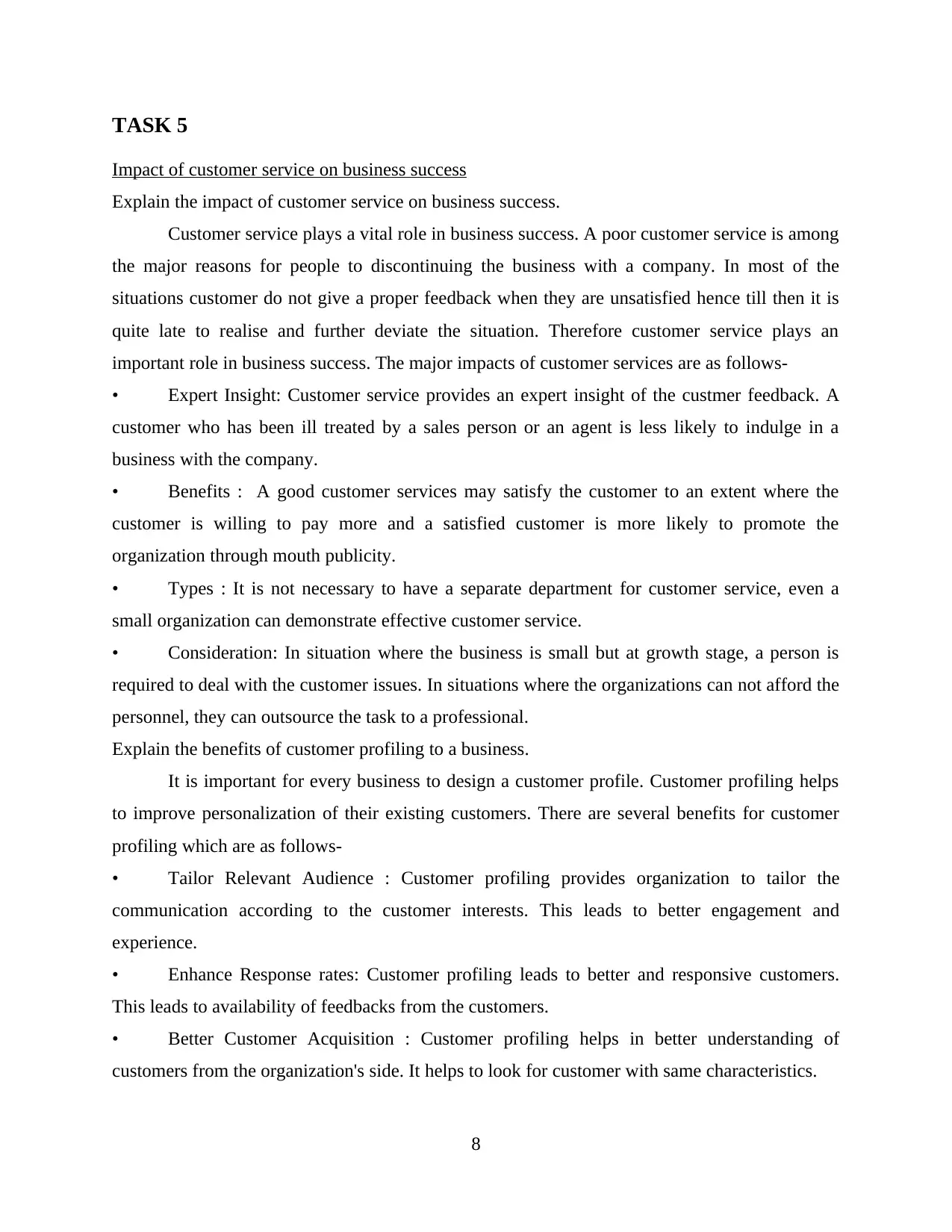
TASK 5
Impact of customer service on business success
Explain the impact of customer service on business success.
Customer service plays a vital role in business success. A poor customer service is among
the major reasons for people to discontinuing the business with a company. In most of the
situations customer do not give a proper feedback when they are unsatisfied hence till then it is
quite late to realise and further deviate the situation. Therefore customer service plays an
important role in business success. The major impacts of customer services are as follows-
• Expert Insight: Customer service provides an expert insight of the custmer feedback. A
customer who has been ill treated by a sales person or an agent is less likely to indulge in a
business with the company.
• Benefits : A good customer services may satisfy the customer to an extent where the
customer is willing to pay more and a satisfied customer is more likely to promote the
organization through mouth publicity.
• Types : It is not necessary to have a separate department for customer service, even a
small organization can demonstrate effective customer service.
• Consideration: In situation where the business is small but at growth stage, a person is
required to deal with the customer issues. In situations where the organizations can not afford the
personnel, they can outsource the task to a professional.
Explain the benefits of customer profiling to a business.
It is important for every business to design a customer profile. Customer profiling helps
to improve personalization of their existing customers. There are several benefits for customer
profiling which are as follows-
• Tailor Relevant Audience : Customer profiling provides organization to tailor the
communication according to the customer interests. This leads to better engagement and
experience.
• Enhance Response rates: Customer profiling leads to better and responsive customers.
This leads to availability of feedbacks from the customers.
• Better Customer Acquisition : Customer profiling helps in better understanding of
customers from the organization's side. It helps to look for customer with same characteristics.
8
Impact of customer service on business success
Explain the impact of customer service on business success.
Customer service plays a vital role in business success. A poor customer service is among
the major reasons for people to discontinuing the business with a company. In most of the
situations customer do not give a proper feedback when they are unsatisfied hence till then it is
quite late to realise and further deviate the situation. Therefore customer service plays an
important role in business success. The major impacts of customer services are as follows-
• Expert Insight: Customer service provides an expert insight of the custmer feedback. A
customer who has been ill treated by a sales person or an agent is less likely to indulge in a
business with the company.
• Benefits : A good customer services may satisfy the customer to an extent where the
customer is willing to pay more and a satisfied customer is more likely to promote the
organization through mouth publicity.
• Types : It is not necessary to have a separate department for customer service, even a
small organization can demonstrate effective customer service.
• Consideration: In situation where the business is small but at growth stage, a person is
required to deal with the customer issues. In situations where the organizations can not afford the
personnel, they can outsource the task to a professional.
Explain the benefits of customer profiling to a business.
It is important for every business to design a customer profile. Customer profiling helps
to improve personalization of their existing customers. There are several benefits for customer
profiling which are as follows-
• Tailor Relevant Audience : Customer profiling provides organization to tailor the
communication according to the customer interests. This leads to better engagement and
experience.
• Enhance Response rates: Customer profiling leads to better and responsive customers.
This leads to availability of feedbacks from the customers.
• Better Customer Acquisition : Customer profiling helps in better understanding of
customers from the organization's side. It helps to look for customer with same characteristics.
8
Paraphrase This Document
Need a fresh take? Get an instant paraphrase of this document with our AI Paraphraser
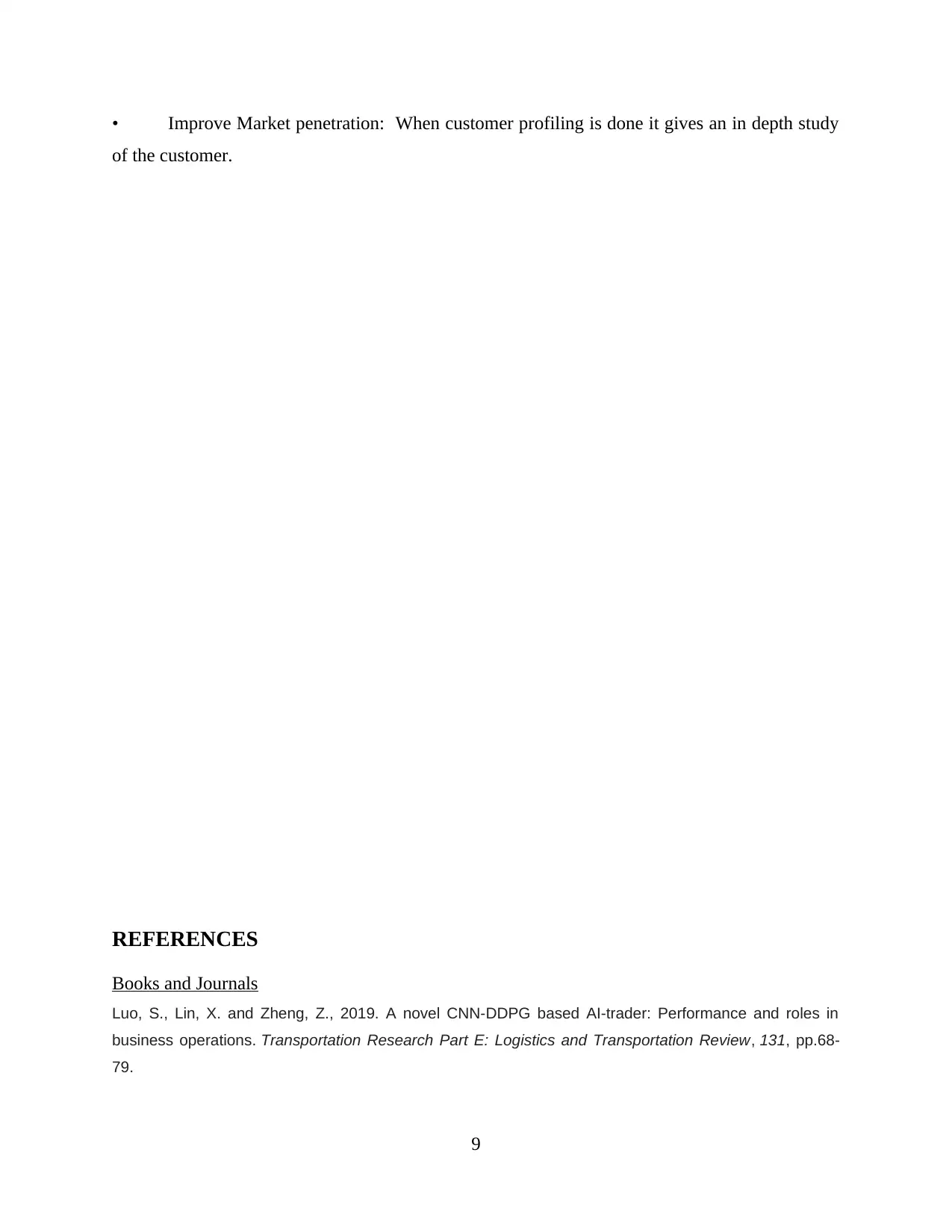
• Improve Market penetration: When customer profiling is done it gives an in depth study
of the customer.
REFERENCES
Books and Journals
Luo, S., Lin, X. and Zheng, Z., 2019. A novel CNN-DDPG based AI-trader: Performance and roles in
business operations. Transportation Research Part E: Logistics and Transportation Review, 131, pp.68-
79.
9
of the customer.
REFERENCES
Books and Journals
Luo, S., Lin, X. and Zheng, Z., 2019. A novel CNN-DDPG based AI-trader: Performance and roles in
business operations. Transportation Research Part E: Logistics and Transportation Review, 131, pp.68-
79.
9
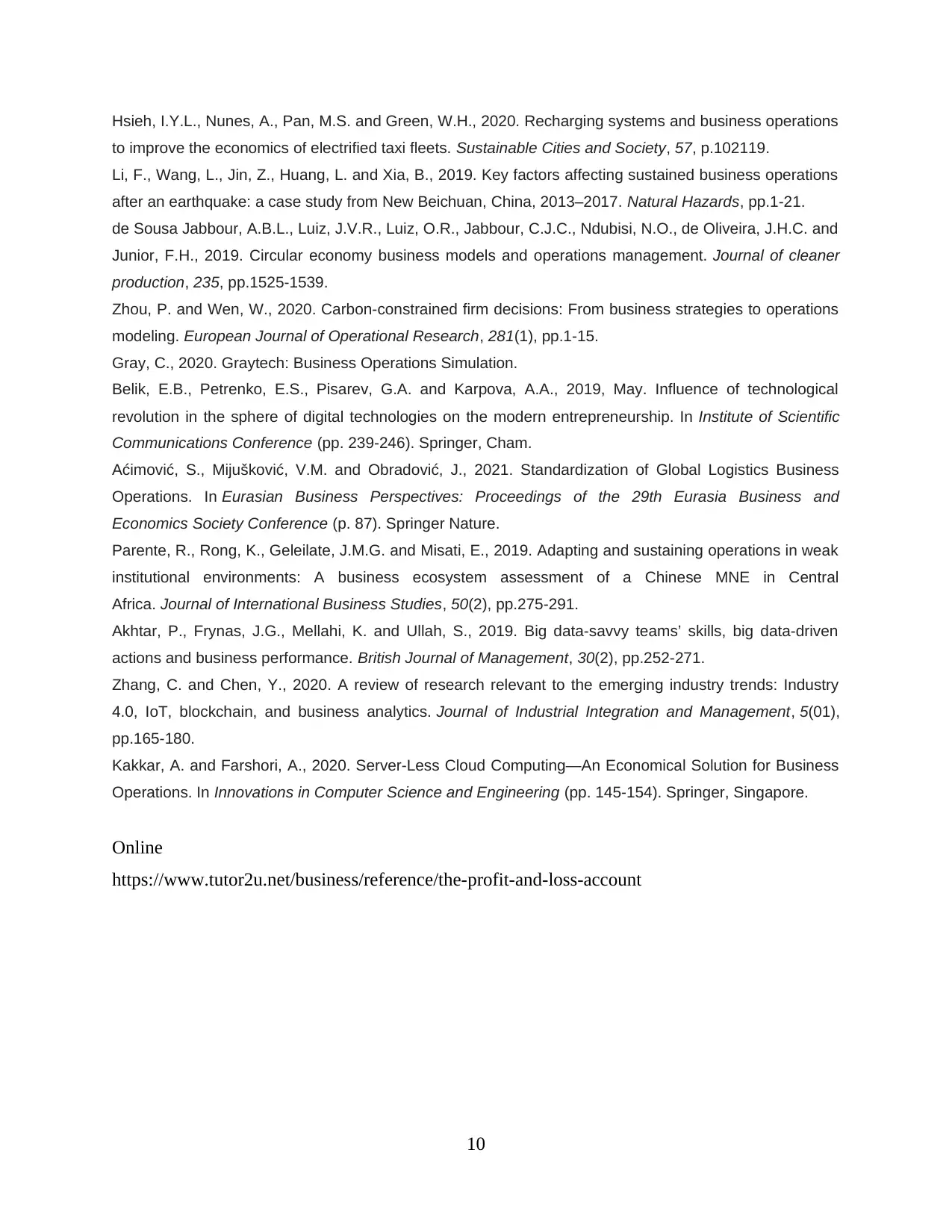
Hsieh, I.Y.L., Nunes, A., Pan, M.S. and Green, W.H., 2020. Recharging systems and business operations
to improve the economics of electrified taxi fleets. Sustainable Cities and Society, 57, p.102119.
Li, F., Wang, L., Jin, Z., Huang, L. and Xia, B., 2019. Key factors affecting sustained business operations
after an earthquake: a case study from New Beichuan, China, 2013–2017. Natural Hazards, pp.1-21.
de Sousa Jabbour, A.B.L., Luiz, J.V.R., Luiz, O.R., Jabbour, C.J.C., Ndubisi, N.O., de Oliveira, J.H.C. and
Junior, F.H., 2019. Circular economy business models and operations management. Journal of cleaner
production, 235, pp.1525-1539.
Zhou, P. and Wen, W., 2020. Carbon-constrained firm decisions: From business strategies to operations
modeling. European Journal of Operational Research, 281(1), pp.1-15.
Gray, C., 2020. Graytech: Business Operations Simulation.
Belik, E.B., Petrenko, E.S., Pisarev, G.A. and Karpova, A.A., 2019, May. Influence of technological
revolution in the sphere of digital technologies on the modern entrepreneurship. In Institute of Scientific
Communications Conference (pp. 239-246). Springer, Cham.
Aćimović, S., Mijušković, V.M. and Obradović, J., 2021. Standardization of Global Logistics Business
Operations. In Eurasian Business Perspectives: Proceedings of the 29th Eurasia Business and
Economics Society Conference (p. 87). Springer Nature.
Parente, R., Rong, K., Geleilate, J.M.G. and Misati, E., 2019. Adapting and sustaining operations in weak
institutional environments: A business ecosystem assessment of a Chinese MNE in Central
Africa. Journal of International Business Studies, 50(2), pp.275-291.
Akhtar, P., Frynas, J.G., Mellahi, K. and Ullah, S., 2019. Big data‐savvy teams’ skills, big data‐driven
actions and business performance. British Journal of Management, 30(2), pp.252-271.
Zhang, C. and Chen, Y., 2020. A review of research relevant to the emerging industry trends: Industry
4.0, IoT, blockchain, and business analytics. Journal of Industrial Integration and Management, 5(01),
pp.165-180.
Kakkar, A. and Farshori, A., 2020. Server-Less Cloud Computing—An Economical Solution for Business
Operations. In Innovations in Computer Science and Engineering (pp. 145-154). Springer, Singapore.
Online
https://www.tutor2u.net/business/reference/the-profit-and-loss-account
10
to improve the economics of electrified taxi fleets. Sustainable Cities and Society, 57, p.102119.
Li, F., Wang, L., Jin, Z., Huang, L. and Xia, B., 2019. Key factors affecting sustained business operations
after an earthquake: a case study from New Beichuan, China, 2013–2017. Natural Hazards, pp.1-21.
de Sousa Jabbour, A.B.L., Luiz, J.V.R., Luiz, O.R., Jabbour, C.J.C., Ndubisi, N.O., de Oliveira, J.H.C. and
Junior, F.H., 2019. Circular economy business models and operations management. Journal of cleaner
production, 235, pp.1525-1539.
Zhou, P. and Wen, W., 2020. Carbon-constrained firm decisions: From business strategies to operations
modeling. European Journal of Operational Research, 281(1), pp.1-15.
Gray, C., 2020. Graytech: Business Operations Simulation.
Belik, E.B., Petrenko, E.S., Pisarev, G.A. and Karpova, A.A., 2019, May. Influence of technological
revolution in the sphere of digital technologies on the modern entrepreneurship. In Institute of Scientific
Communications Conference (pp. 239-246). Springer, Cham.
Aćimović, S., Mijušković, V.M. and Obradović, J., 2021. Standardization of Global Logistics Business
Operations. In Eurasian Business Perspectives: Proceedings of the 29th Eurasia Business and
Economics Society Conference (p. 87). Springer Nature.
Parente, R., Rong, K., Geleilate, J.M.G. and Misati, E., 2019. Adapting and sustaining operations in weak
institutional environments: A business ecosystem assessment of a Chinese MNE in Central
Africa. Journal of International Business Studies, 50(2), pp.275-291.
Akhtar, P., Frynas, J.G., Mellahi, K. and Ullah, S., 2019. Big data‐savvy teams’ skills, big data‐driven
actions and business performance. British Journal of Management, 30(2), pp.252-271.
Zhang, C. and Chen, Y., 2020. A review of research relevant to the emerging industry trends: Industry
4.0, IoT, blockchain, and business analytics. Journal of Industrial Integration and Management, 5(01),
pp.165-180.
Kakkar, A. and Farshori, A., 2020. Server-Less Cloud Computing—An Economical Solution for Business
Operations. In Innovations in Computer Science and Engineering (pp. 145-154). Springer, Singapore.
Online
https://www.tutor2u.net/business/reference/the-profit-and-loss-account
10
⊘ This is a preview!⊘
Do you want full access?
Subscribe today to unlock all pages.

Trusted by 1+ million students worldwide
1 out of 13
Related Documents
Your All-in-One AI-Powered Toolkit for Academic Success.
+13062052269
info@desklib.com
Available 24*7 on WhatsApp / Email
![[object Object]](/_next/static/media/star-bottom.7253800d.svg)
Unlock your academic potential
Copyright © 2020–2025 A2Z Services. All Rights Reserved. Developed and managed by ZUCOL.



